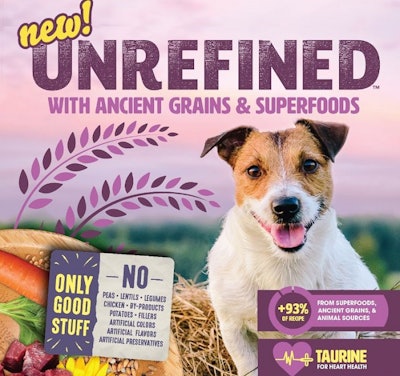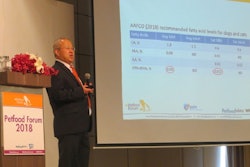
In June 2019, American Natural Premium, a pet food company based in Wisconsin, launched a dog food line with this prominent claim: “legume-free.”
I wondered at the time if this signified a trend, a market response to all the concern and press coverage of the U.S. Food and Drug Administration’s (FDA) ongoing investigation into recent cases of canine dilated cardiomyopathy (DCM) and their potential link to grain-free pet foods, which often include legumes as key ingredients.
Well, we didn’t have to wait long: The trend is here. Numerous pet food and topper companies launched new products at SuperZoo 2019, August 20-22 in Las Vegas, featuring not only legume-free claims and ones related to grains – think “grain friendly,” “grain in,” “whole grains,” “ancient grains” – but also ones focused on taurine supplementation, as low taurine can lead to development of DCM. (Emphasis on “can”; in some of the recent cases, the affected dogs had normal levels of taurine.) Signage in booths focused on these concerns, too.
Though the root causes of these DCM cases are far from being uncovered, let alone understood, it seems pet food companies are not waiting for definitive results from the FDA and other investigations. These companies are seizing what they see as a market opportunity now.
DCM-related products not a surprise, but are they premature?
Disclaimer: I was not at SuperZoo; instead, I was in Shanghai hosting Petfood Forum China 2019 and attending Pet Fair Asia, another large pet trade show. But three of my colleagues did attend SuperZoo and reported all the new DCM-related products and signs. In addition, one talked to a few ingredient suppliers who are seeing changes in their business due to pet food companies pulling back on grain-free or legume-included products.
None of this flurry of new products comes as a surprise: Besides the American Natural Premium launch in June 2019, we also started receiving press releases before SuperZoo promoting some of the other launches. Plus, it just makes sense for pet food brands to adopt this product development approach.
Since FDA first launched its DCM advisory in July 2018, many pet owners, veterinarians and pet retailers have expressed deep, continual worry over whether the foods they were feeding or seeing on the market were healthy for dogs. With the investigations into these DCM cases likely taking additional years to find a root cause, it’s understandable that some companies didn’t see the logic in waiting for results to respond to such concerns with different products.
Yet this new trend still seems premature and, like the one it may be replacing – grain-free pet food – not backed by science or even by FDA’s own data. I find it somewhat ironic that some of the same entities who for years have bashed grains in pet food as being bad for dogs and cats (despite no scientific proof) may now be the very ones turning away from grain free. Again, with no real scientific basis for doing so.
On the other hand, we do have years and reams of peer-reviewed studies showing grains are not harmful to dogs and cats; and in fact, many of them offer distinct nutritional and other benefits. So going back to grains in pet food will certainly not harm pets. The same with adding taurine: Not every companion animal nutritionist is convinced this is necessary or advised, but nearly all agree it won’t hurt, other than potentially adding cost to products. (And possibly causing a run on taurine supplies.)
People outside of U.S. paying attention to DCM investigations
While the Chinese pet food market is growing fast and very quickly adopting trends from the U.S. and other developed markets, I didn’t see a sign of DCM-related claims or products at Pet Fair Asia. But that doesn’t mean people outside the U.S. aren’t paying attention to this situation. I received a few questions about it from English-speaking people at Chinese pet food companies, and some Petfood Forum China speakers from other countries mentioned it in relation to ingredient and nutrition research they were presenting.
For example, Emma Bermingham, Ph.D., senior scientist with AgReseach in New Zealand (and affiliated with the companion animal program at Massey University there), presented new research on the role of dietary fiber in fecal and gut health in dogs and cats. She commented that high-fiber diets – a term that can apply to foods with high levels of pulses and legumes – have been shown to increase the abundance of microbes that break down taurine in the intestinal lumen, preventing it from being recycled in the body. And as other nutritionists have, she pointed out that legumes are low in key amino acids such as methionine, cysteine and taurine.
Yet, again, no one truly knows whether high amounts of legumes in pet foods have played a role in the new cases of DCM; Bermingham also pointed out that not all the foods identified were grain free or included legumes, despite high percentages that did. There is still so much to learn about the recent cases of canine DCM.
Meanwhile, dog owners need to keep feeding their pets, and pet food companies need to keep developing and marketing products – leading to new trends in the market.
















